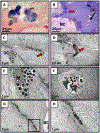Chronic Osteomyelitis with Staphylococcus aureus Deformation in Submicron Canaliculi of Osteocytes: A Case Report
- PMID: 29443819
- PMCID: PMC6681818
- DOI: 10.2106/JBJS.CC.17.00154
Chronic Osteomyelitis with Staphylococcus aureus Deformation in Submicron Canaliculi of Osteocytes: A Case Report
Abstract
Case: A patient presenting with an infected diabetic foot ulcer and Staphylococcus aureus chronic osteomyelitis was studied to validate the clinical importance of bacterial colonization of osteocytic-canalicular networks, as we recently reported in a mouse model. We utilized transmission electron microscopy to describe the deformation of S. aureus, from round cocci to rod-shaped bacteria, in the submicron osteocytic-canalicular networks of amputated bone tissue.
Conclusion: To our knowledge, this is the first evidence of S. aureus deformation and invasion of the osteocytic-canalicular system in human bone, which supports a new mechanism of persistence in the pathogenesis of chronic osteomyelitis.
Figures


References
-
- Rice JB, Desai U, Cummings AK, Birnbaum HG, Skornicki M, Parsons NB. Burden of diabetic foot ulcers for Medicare and private insurers. Diabetes Care. 2014;37(3):651–8. Epub 2013 Nov 1. - PubMed
-
- Lipsky BA. Medical treatment of diabetic foot infections. Clin Infect Dis. 2004. August 1;39(Suppl 2):S104–14. - PubMed
-
- Hudson MC, Ramp WK, Nicholson NC, Williams AS, Nousiainen MT. Internalization of Staphylococcus aureus by cultured osteoblasts. Microb Pathog. 1995. December;19(6):409–19. - PubMed
-
- Ellington JK, Harris M, Webb L, Smith B, Smith T, Tan K, Hudson M. Intracellular Staphylococcus aureus. A mechanism for the indolence of osteomyelitis. J Bone Joint Surg Br. 2003. August;85(6):918–21. - PubMed
-
- Reilly SS, Hudson MC, Kellam JF, Ramp WK. In vivo internalization of Staphylococcus aureus by embryonic chick osteoblasts. Bone. 2000. January;26(1):63–70. - PubMed
Publication types
MeSH terms
Grants and funding
LinkOut - more resources
Full Text Sources
Other Literature Sources
Medical

